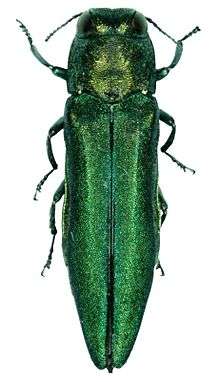Fraxinus
Fraxinus /ˈfræksɪnəs/,[4] English name ash, is a genus of flowering plants in the olive and lilac family, Oleaceae. It contains 45–65 species of usually medium to large trees, mostly deciduous, though a number of subtropical species are evergreen. The genus is widespread across much of Europe, Asia, and North America.[3][5][6][7][8]
| Fraxinus | |
|---|---|
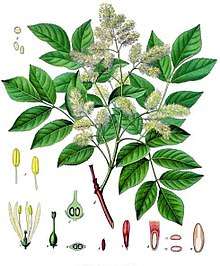 | |
| Fraxinus ornus 1862 illustration[1] | |
| Scientific classification | |
| Kingdom: | Plantae |
| Clade: | Tracheophytes |
| Clade: | Angiosperms |
| Clade: | Eudicots |
| Clade: | Asterids |
| Order: | Lamiales |
| Family: | Oleaceae |
| Tribe: | Oleeae |
| Subtribe: | Fraxininae |
| Genus: | Fraxinus L.[2] |
| Synonyms[3] | |
| |

The leaves are opposite (rarely in whorls of three), and mostly pinnately compound, simple in a few species. The seeds, popularly known as "keys" or "helicopter seeds", are a type of fruit known as a samara. Most Fraxinus species are dioecious, having male and female flowers on separate plants[9] but sex in ash is expressed as a continuum between male and female individuals, dominated by unisexual trees. With age, ash may change their sexual function from predominantly male and hermaphrodite towards femaleness;[10] if grown as an ornamental and both sexes are present, ashes can cause a considerable litter problem with their seeds. Rowans or mountain ashes have leaves and buds superficially similar to those of true ashes, but belong to the unrelated genus Sorbus in the rose family.
Etymology
The tree's common English name, "ash", traces back to the Old English æsc, which relates to the proto-Indo-European for the tree, while the generic name originated in Latin from a proto-Indo-European word for birch. Both words are also used to mean "spear" in their respective languages, as the wood is good for shafts.[11]
Selected species
Species are arranged into sections supported by phylogenetic analysis:[12][13]
- Section Dipetalae
- Fraxinus anomala Torr. ex S.Watson – singleleaf ash
- Fraxinus dipetala Hook. & Arn. – California ash or two-petal ash
- Fraxinus quadrangulata Michx. – blue ash
- Fraxinus trifoliata
- Section Fraxinus
- Fraxinus angustifolia Vahl – narrow-leafed ash
- Fraxinus angustifolia subsp. oxycarpa – Caucasian ash
- Fraxinus angustifolia subsp. syriaca
- Fraxinus excelsior L. – European ash
- Fraxinus holotricha Koehne
- Fraxinus mandschurica Rupr. – Manchurian ash
- Fraxinus nigra Marshall – black ash
- Fraxinus pallisiae Wilmott – Pallis' ash
- Fraxinus sogdiana Bge
- Section Melioides sensu lato
- Fraxinus chiisanensis
- Fraxinus cuspidata Torr. – fragrant ash
- Fraxinus platypoda
- Fraxinus spaethiana Lingelsh. – Späth's ash
- Section Melioides sensu stricto
- Fraxinus albicans Buckley – Texas ash
- Fraxinus americana L. – white ash or American ash
- Fraxinus berlandieriana DC. – Mexican ash
- Fraxinus caroliniana Mill. – Carolina ash
- Fraxinus latifolia Benth. – Oregon ash
- Fraxinus papillosa Lingelsh. – Chihuahua ash
- Fraxinus pennsylvanica Marshall – green ash
- Fraxinus profunda (Bush) Bush – pumpkin ash
- Fraxinus uhdei (Wenz.) Lingelsh. – Shamel ash or tropical ash
- Fraxinus velutina Torr. – velvet ash or Arizona ash
- Section Ornus
- Fraxinus apertisquamifera
- Fraxinus baroniana
- Fraxinus bungeana DC. – Bunge's ash
- Fraxinus chinensis Roxb. – Chinese ash or Korean ash
- Fraxinus floribunda Wall. – Himalayan manna ash
- Fraxinus griffithii C.B.Clarke – Griffith's ash
- Fraxinus japonica – Japanese ash
- Fraxinus lanuginosa – Japanese ash
- Fraxinus longicuspis
- Fraxinus malacophylla
- Fraxinus micrantha Lingelsh.
- Fraxinus ornus L. – manna ash or flowering ash
- Fraxinus paxiana Lingelsh.
- Fraxinus sieboldiana Blume – Japanese flowering ash
- Section Pauciflorae
- Fraxinus dubia
- Fraxinus gooddingii – Goodding's ash
- Fraxinus greggii A.Gray – Gregg's ash
- Fraxinus purpusii
- Fraxinus rufescens
- Section Sciadanthus
- Fraxinus dimorpha
- Fraxinus hubeiensis Ch'u & Shang & Su – 湖北梣 hu bei qin
- Fraxinus xanthoxyloides (G.Don) Wall. ex DC. – Afghan ash[14][15]
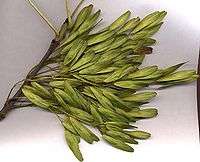 Closeup of European ash seeds
Closeup of European ash seeds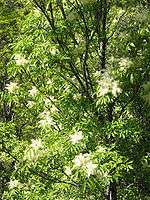 F. ornus
F. ornus- Unusual "treelets" growing from a fallen ash tree in Lawthorn Wood, Ayrshire, Scotland
Ecology
North American native ash tree species are a critical food source for North American frogs, as their fallen leaves are particularly suitable for tadpoles to feed upon in ponds (both temporary and permanent), large puddles, and other water bodies.[16] Lack of tannins in the American ash makes their leaves a good food source for the frogs, but also reduces its resistance to the ash borer. Species with higher leaf tannin levels (including maples and non-native ash species) are taking the place of native ash, thanks to their greater resistance to the ash borer. They produce much less suitable food for the tadpoles, resulting in poor survival rates and small frog sizes.[16]
Ash species native to North America also provide important habit and food for various other creatures native to North America. This includes the larvae of multiple long-horn beetles, as well as other insects including those in the genus Tropidosteptes, lace bugs, aphids, larvae of gall flies, and caterpillars. Birds are also interested in black, green, and white ash trees. The black ash alone supports wood ducks, wild turkey, cardinals, pine grosbeaks, cedar waxwings, and yellow-bellied sapsuckers, with habitat and food (such as the sap being of interest to the sapsucker) among others. Many mammalian species from meadow voles eating the seeds, white-tailed deer eating the foliage, to silver-haired bats nesting, will also make use of ash trees. [17][18][19][20]
Ash is used as a food plant by the larvae of some Lepidoptera species (butterflies and moths).
Threats
The emerald ash borer (Agrilus planipennis, EAB) is a wood-boring beetle accidentally introduced to North America from eastern Asia via solid wood packing material in the late 1980s to early 1990s. It has killed tens of millions of trees in 22 states in the United States[21] and adjacent Ontario and Quebec in Canada. It threatens some seven billion ash trees in North America. Research is being conducted to determine if three native Asian wasps that are natural predators of EAB could be used as a biological control for the management of EAB populations in the United States. The public is being cautioned not to transport unfinished wood products, such as firewood, to slow the spread of this insect pest.[22]
The European ash, Fraxinus excelsior, has been affected by the fungus Hymenoscyphus fraxineus, causing ash dieback[23] in a large number of trees since the mid-1990s, particularly in eastern and northern Europe.[24][25] The disease has infected about 90% of Denmark's ash trees.[26] At the end of October 2012 in the UK, the Food and Environment Research Agency reported that ash dieback had been discovered in mature woodland in Suffolk; previous occurrences had been on young trees imported from Europe.[27] In 2016, the ash tree was reported as in danger of extinction in Europe.[28]
Uses by Humans
Ash is a hardwood and is hard, dense (within 20% of 670 kg/m3 for Fraxinus americana,[29] and higher at 710 kg/m3 for Fraxinus excelsior[30]), tough and very strong but elastic, extensively used for making bows, tool handles, baseball bats, hurleys, and other uses demanding high strength and resilience.

Ash is a minor material for electric guitar bodies[31] and, less commonly, for acoustic guitar bodies, known for its bright, cutting edge and sustaining quality. Some Fender Stratocasters and Telecasters are made of ash, (such as Bruce Springsteen's Telecaster on the Born to Run album cover), as an alternative to alder. They are also used for making drum shells.
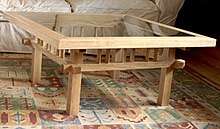
Woodworkers generally consider ash a "poor cousin" to the other major open pore wood, oak, but it is useful in any furniture application. Ash veneers are extensively used in office furniture. Ash is not used much outdoors due to the heartwood having a low durability to ground contact, meaning it will typically perish within five years. The F. japonica species is favored as a material for making baseball bats by Japanese sporting-goods manufacturers. [32]
Its robust structure, good looks, and flexibility combine to make ash ideal for staircases. Ash stairs are extremely hard-wearing, which is particularly important for treads. Due to its elasticity, ash can also be steamed and bent to produce curved stair parts such as volutes (curled sections of handrail) and intricately shaped balusters. However, a reduction in the supply of healthy trees, especially in Europe, is making ash an increasingly expensive option.
Ash was commonly used for the structural members of the bodies of cars made by carriage builders. Early cars had frames which were intended to flex as part of the suspension system to simplify construction. The Morgan Motor Company of Great Britain still manufacture sports cars with frames made from ash. It was also widely used by early aviation pioneers for aircraft construction.
It lights and burns easily, so is used for starting fires and barbecues, and is usable for maintaining a fire, though it produces only a moderate heat. The two most economically important species for wood production are white ash, in eastern North America, and European ash in Europe. The green ash (F. pennsylvanica) is widely planted as a street tree in the United States. The inner bark of the blue ash (F. quadrangulata) has been used as a source for blue dye.
The leaves of ash are appreciated by cattle, goats, and rabbits. Cut off in the autumn, the branches can be a valuable winter supply for domestic animals.
Mythology and folklore
In Greek mythology, the Meliae are nymphs associated with the ash, perhaps specifically of the manna ash (Fraxinus ornus), as dryads were nymphs associated with the oak. They appear in Hesiod's Theogony.
In Norse mythology, a vast, evergreen ash tree Yggdrasil ("the steed (gallows) of Odin"), watered by three magical springs, serves as axis mundi, sustaining the nine worlds of the cosmos in its roots and branches. Askr, the first man in Norse myth, literally means 'ash'.[33]
See also
- List of Lepidoptera that feed on ashes
- Æ, the letter ash
References
- Franz Eugen Köhler, Köhler's Medizinal-Pflanzen
- "Fraxinus L." Germplasm Resources Information Network. United States Department of Agriculture. 3 April 2006. Retrieved 21 August 2016.
- "Fraxinus". World Checklist of Selected Plant Families. Kew Royal Botanical Gardens. Retrieved 16 April 2016.
- Sunset Western Garden Book, 1995, pp. 606–607
- "Fraxinus". Altervista Flora Italiana. Retrieved 16 April 2016.
- "Fraxinus Linnaeus, Sp. Pl. 2: 1057. 1753". Flora of China. p. 273 – via 衿属 qin shu.
- Philips, Roger (1979). Trees of North America and Europe: A Guide to Field Identification, Revised and Updated. New York: Random House. ISBN 0-394-50259-0. OCLC 4036251.
- "Genus Fraxinus". US Department of Agriculture. Retrieved 21 August 2016.
- "Monoecious and dioecious plants". saylorplants.com. Retrieved 15 April 2013.
- Gender variation in ash (Fraxinus excelsior L.) Pierre Binggeli & James Power (1991)
- Mallory, J. P.; Adams, Douglas Q., eds. (1997). Encyclopedia of Indo-European culture. Taylor & Francis. p. 32. ISBN 978-1-884964-98-5.
- "Systematics of Fraxinus (Oleaceae) and evolution of dioecy" (PDF). Retrieved 28 August 2016.
- Hinsinger, Damien Daniel; Basak, Jolly; Gaudeul, Myriam; Cruaud, Corinne; Bertolino, Paola; Frascaria-Lacoste, Nathalie; Bousquet, Jean (21 November 2013). "The Phylogeny and Biogeographic History of Ashes ( Fraxinus, Oleaceae) Highlight the Roles of Migration and Vicariance in the Diversification of Temperate Trees". PLOS ONE. 8 (11): e80431. doi:10.1371/journal.pone.0080431. PMC 3837005. PMID 24278282.
- "Species Records of Fraxinus". Germplasm Resources Information Network. United States Department of Agriculture. Retrieved 22 February 2010.
- "Fraxinus L." ITIS Standard Reports. Integrated Taxonomic Information System. Retrieved 22 February 2010.
- Stephens, Jeffrey; Bervan, Keith; Tiegs, Scott (3 May 2013). "Anthropogenic changes to leaf litter input affect the fitness of a larval amphibian". Freshwater Biology. 58 (8): 1631–1646. doi:10.1111/fwb.12155.
- "Black Ash". Illinois Wildflowers. Dr. John Hilty. Retrieved 27 August 2018.
- "White Ash". Illinois Wildflowers. Dr. John Hilty. Retrieved 27 August 2018.
- "Green Ash". Illinois Wildflowers. Dr. John Hilty. Retrieved 27 August 2018.
- "Red Ash". Illinois Wildflowers. Dr. John Hilty. Retrieved 27 August 2018.
- Moy, Derek. "Emerald Ash Borer - About Emerald Ash Borer (EAB)". www.emeraldashborer.info.
- "The Problem". Don't Move Firewood. Retrieved 14 October 2011.
- Kowalski T (2006) Chalara fraxinea sp. nov. associated with dieback of ash (Fraxinus excelsior) in Poland. Forest Pathology 36(4), 264-270
- E. Halmschlager & T. Kirisits (2008). "First report of the ash dieback pathogen Chalara fraxinea on Fraxinus excelsior in Austria". New Disease Reports. 17: 20. Retrieved 10 February 2010.
- N. Ogris, T. Hauptman & D. Jurc (2009). "Chalara fraxinea causing common ash dieback newly reported in Slovenia". New Disease Reports. 19: 15. Retrieved 10 February 2010.
- "'Ash dieback' fungus Chalara fraxinea in UK countryside". BBC. 25 October 2012. Retrieved 25 October 2012.
- BBC News 'Ash dieback' fungus, Chalara fraxinea found in UK countryside. Retrieved 25 October 2012.
- Marshall, Claire (23 March 2016). "Ash tree set for extinction in Europe". BBC.
- "White Ash". Niche Timbers. Retrieved 22 February 2010.
- "Ash". Niche Timbers. Retrieved 22 February 2010.
- https://www.commercialforestproducts.com/good-swamp-ash/
- "美津和タイガー/野球博物館/バットのできるまで". www.mitsuwa-tiger.com.
- Simek, Rudolf (2007). Dictionary of Northern Mythology. Translated by Angela Hall. D.S. Brewer. ISBN 978-0-85991-513-7.
External links
| Wikimedia Commons has media related to Fraxinus. |
| Wikispecies has information related to Fraxinus |
